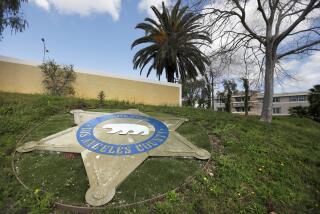Rampart-Like Scandal Rocks Oakland Justice System, Politics
- Share via
OAKLAND — Four veteran cops who worked the midnight shift in this city’s tough northwest corner, they called themselves the “Riders”--peacekeepers on some mythic outlaw frontier.
But their romantic nickname is now shorthand for the worst police scandal in Oakland’s recent history, as the Riders face criminal charges and a federal civil rights lawsuit alleging that they fabricated evidence, planted drugs and wantonly beat suspects bloody.
The Riders case, which is frequently compared with the Rampart police scandal in Los Angeles, stems from accusations by a 23-year-old rookie cop. He spent two weeks last summer patrolling predominantly black West Oakland with the four officers before quitting the force, reportedly in disgust.
The Alameda County district attorney’s office is reviewing hundreds of arrests that the officers made in the last 18 months. So far, convictions have been overturned or pending cases dismissed for dozens of people because of questionable police testimony.
The widening scandal has aroused more strong feelings in this comeback city of 395,000 than perhaps anything since the return of the Raiders football team in 1995. It has stirred racial tensions, raised questions about the Oakland Police Department’s monitoring of officers who abuse authority, and cast Mayor Jerry Brown, the old-time social progressive, as a huffy, law-and-order zealot.
Brown, elected in 1998 with a promise to improve the quality of life in Oakland, made reducing crime a key goal of his administration. And despite an uptick in homicides in the last year, serious crime overall has fallen on his watch. But critics and some community activists say the Riders’ alleged excesses show what happens when cops take the boss’ get-tough approach too literally.
In West Oakland, an area pinched between downtown and the industrial waterfront, many residents expressed deep gratitude for Brown’s initiatives, saying the neighborhood is safer today than it was just a few years ago. But others say police act like an occupying army. They believe--and fear--that the stepped-up enforcement efforts are intended to spur gentrification in the area.
Already, moneyed Silicon Valley workers are snapping up decayed Victorians and displacing residents, 80% of whom are renters, said Monsa Nitoto, a member of a group trying to save the area’s African American heritage.
Brown said in an interview that it is “preposterous on its face” to suggest that his directive to slash crime had contributed to the alleged police abuses.
“I did state the goal that the Police Department should strive for a 20% reduction in crime,” he said. The mayor was incredulous at a suggestion that “to maintain respect for constitutional rights, the mayor should not set a numerical goal for crime reduction.”
He also defended the Police Department against claims that the scandal reflects a broader pattern of officers’ targeting African American residents in poorer neighborhoods.
“I know of no evidence that supports that allegation,” Brown said.
Nonetheless, the Riders case promises to engage the city for months as it marches through the justice system.
One Officer Is a Fugitive
Three of the accused officers--Clarence Mabanag, Jude Siapno and Matthew Hornung--pleaded not guilty Wednesday in Superior Court here.
The fourth, Francisco Vazquez, a fugitive for nearly a month, failed to appear at the arraignment and is being hunted by his own department, the district attorney’s office and the FBI.
Vazquez, the group’s senior officer, was reportedly known on the streets as the “Choker” for squeezing a suspect’s throat during questioning.
Defense attorneys contend that the straight-from-the-academy rookie informant, Keith Batt, is not credible. They say he misstated basic facts about where and when alleged misconduct took place.
Attorney Michael Rains said in an interview that Batt is a “white boy from the suburbs” whose judgment was clouded by “culture shock” experienced on the graveyard shift in violence-prone West Oakland. The ethnic makeup of the accused officers is mixed: a white, a Latino and two Filipino Americans.
The criminal complaint, which includes 34 felony and misdemeanor counts, is limited to eight incidents that Batt witnessed in late June and early July, said Deputy Dist. Atty. David Hollister.
One involved Delphine Allen, whom the Riders allegedly kidnapped and took to a “remote location.” There, according to the complaint, Officer Siapno beat the handcuffed prisoner in the “face, stomach, back and legs” while Vazquez watched. Allen was arrested on suspicion of drug possession--framed, the complaint says--and jailed on charges that would be dropped in the emerging scandal.
County prosecutor Hollister said he did not try to learn whether the Riders engaged in wrongdoing before the brief period last summer that the rookie witnessed.
But a sweeping federal class-action lawsuit filed Thursday alleges that they did. It names 12 plaintiffs, including four identified in the criminal complaint, and will add others as they come forward, according to attorneys John Burris and James Chanin. An additional 15 people whom the Riders arrested or accosted under questionable circumstances in the last few years have expressed interest in joining the suit, the attorneys said.
The suit alleges that the officers violated the plaintiffs’ civil rights by using excessive force, depriving them of liberty without due legal process and discriminating against them because of their race. It seeks punitive damages as well as payments for the alleged victims’ pain and suffering, medical expenses, lost work and legal fees.
At a news conference Thursday, six of the plaintiffs, all young African American males, told of run-ins with one or more of the Riders. Five said the officers planted one or more pieces of crack cocaine on them.
Bobby Pree said he was walking home late one night in October 1999 when Vazquez stopped him. Then, while he was handcuffed in the back of the police cruiser, the plaintiff said, he saw the officer rummage in the car trunk, put a cocaine rock in a bag and claim it was Pree’s. He was arrested and jailed on suspicion of drug possession, but his case was dismissed this fall.
In addition to seeking monetary damages, the lawsuit requests that the U.S. Department of Justice investigate the department, partly because it showed “deliberate indifference” to the Riders’ abuses, which must have been known to command officers, the attorneys say. The department has engaged in a “pattern and practice of police misconduct against African Americans,” the lawyers say.
In Oakland, blacks make up 43% of the population, whites 33% and Latinos 14%. Out of the Police Department’s 750 sworn officers, 26% are black, 45% white and 16% Latino.
The Riders case has already prompted some police reform. The department will now monitor squadrons for unusual arrest patterns, said police spokesman George Phillips. Also, he said, a new position of inspector general, reporting to the chief and working independently of the internal affairs division, has been created to address complaints of excessive force and other abuses.
To critics who say the department cannot monitor itself, authorities counter that the Riders case shows otherwise. Prosecutors say that the rookie officer’s complaints prompted immediate internal review and that all evidence of criminal wrongdoing was delivered quickly to the district attorney. Last week, the department fired Siapno and Mabanag, while termination proceedings are underway against Hornung and fugitive Vazquez.
Some Differences in Scandals
The Riders and Rampart scandals have similarities--cops accused of hammering suspects, faking evidence, making bogus arrests--but to many in Oakland the differences seem more important.
In contrast to the Rampart Division controversy that has plagued the Los Angeles Police Department for more than a year, the Oakland Police Department handled the allegations of wrongdoing speedily and has cooperated fully with prosecutors, Hollister said.
Another difference, said Burris, author of a 1999 book on police brutality against African Americans, was the apparent motivation for the alleged abuses. With Rampart, he said, the disgraced cops seemed partly motivated by personal gain, such as profiting from confiscated drugs. But there is no evidence of that with the Riders, he said.
Sometimes the Riders framed suspects and then offered to let them go if they turned others in; other times they simply went too far, Burris said.
Antonio Wagner, a likely plaintiff in the federal civil suit, says he was kicked by one of the Riders while lying face down on the street last year after being pulled over in West Oakland. He used to lay carpets but can no longer work full time because of the “humongous” pain, he said.
He was not arrested. “I wasn’t doing anything,” he said, “and I end up with my ribs broken.”
More to Read
Sign up for Essential California
The most important California stories and recommendations in your inbox every morning.
You may occasionally receive promotional content from the Los Angeles Times.










